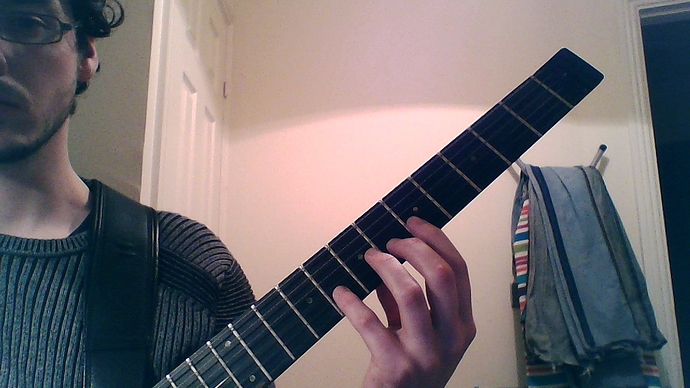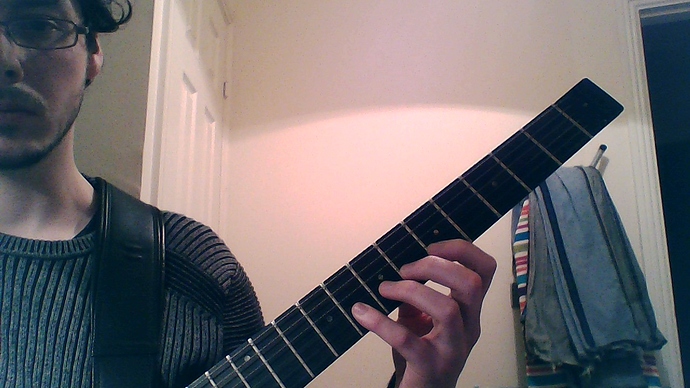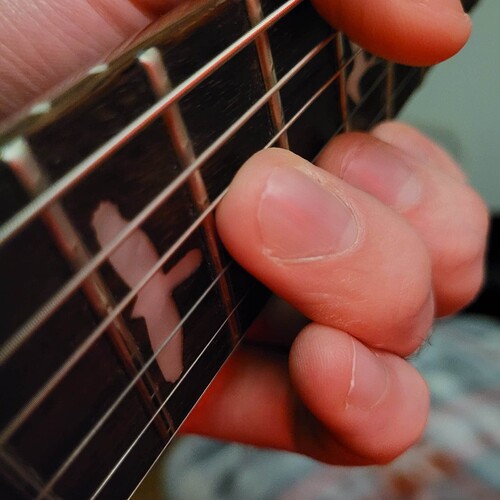Hello,
I recently started learning Altitudes by Jason Becker and I’ve practicing a few of the descending sweeps as licks and this one in particular has a third finger barre in the middle of it, i.e. on the 3rd and 4th string. 
The barre is no problem but whenever I try to do it at speed, I end up hitting the 5th string and making it ring out as a result. I was wondering if there’s a way to mute that or if the sound is going to simply be unnoticeable when brought up to its original speed and I shouldn’t worry about it.
Interested in this as well! I’ve been trying to get sweep barres clean and the best answer I can come up with so far is “just, uh, play around with it until you can position your finger perfectly so that one string rings out and the surrounding two are muted!”… which of course is not a particularly actionable solution. 3-string barres are even worse… especially 3-string pinky barres (though that probably doesn’t come up too often in practice).
One possible workaround: can you avoid the barre entirely by going middle-ring-middle-ring or middle-ring-middle-pinky (on the b-g-d-a string sequence)?
I used to have huge trouble with finger rolls. There’s a little bit of a “knack” to it, I’ll try to explain how I’ve learned to do this.
When I begin ascending E minor arpeggio (standard A minor shape at the 7th fret), I begin with my hand in what I call “parallel” posture.
Here’s a picture of “parallel posture” from an old thread on the forum:

Notice that the tip of the index finger points in line with the frets. The tip of the index finger damps the string lower than the string being played, and the underside of the index finger damps all higher strings. The middle, ring and pinky fingers fret close to the tip, and provide little or no damping contact.
The first three notes of this arpeggio are played from this posture with fingers 1, 4 and 3. Then, with the D string under the tip of my ring finger, I shift my posture to a second posture, which I call “angled” posture. Here’s an old picture from the same thread

In angled posture, the tip of my index finger points towards my chin, and every finger frets with the softer pads of the fingers. Each finger damps the string below and the string above the string being played while fretting.
The shift from “parallel” to “angled” posture moves us from fretting the D string with the tip of the ring finger, to fretting the G string with the pad of the ring finger and the D string muted. We call the technique a “finger roll,” but it’s actually accomplished by shifting posture from the wrist and forearm.
The rest of the arpeggio is played in angled posture until we return to the G string in the descending portion. We fret the G string with the same spot on the pad of the ring finger which fretted the G string during the ascending portion. To complete out descent, we shift back from angled posture to parallel posture, and provided we found the right spot on the pad of the ring finger while in angled posture, the ring finger will naturally roll to fret the D string with the finger tip again.
The same idea is extended to rolling with the other fingers, or rolling across more strings, though it is more difficult. As I said, there’s a bit of a knack to it, but there are some things that can’t really be played without developing this skill. Really try to focus on feeling where you need to contact the strings to fret rolled notes.
I might be able to shoot a video tutorial over the next few days, but…
Yeah, I agree with this. @cmcgee11235 is great at playing these two octave sweep shapes. I’m sure he has some solid insights.
You could try using a fret wrap for a few days or weeks to see if you can develop more of the speed to then possibly clean up when your fretting hand gets use to the speed.
I’ve been playing around with that insight of yours and the way I kind of make it work is that the finger is not barring the two strings but rather positioned in a way where it makes contact with both strings (the bottom one with the tip and the top one with the pad) I don’t know if that’s what you are going for. In that situation, switching between those two positions does do the job.
Although, it feels really weird to do  I guess I’ll get used to it by doing it more.
I guess I’ll get used to it by doing it more.
I have to do this many times with some of the chords (seems like here it mainly happens with the middle finger on the chords using the middle finger to fret the low e and a strings, there is one chord with the ring finger banana fretting the high e and b and my hand cannot contort to do it.) Stochelo Rosenberg does, and my hand feels so confused in the beginning. This takes awhile for it to become more second nature, just got to keep doing it all over your doodling.
Nice, glad you got it working, and good demonstration pic. I’ve found that technique works pretty well for 2-string barres… more a a “roll” as opposed to a true barre.
I’m actually wondering if I misinterpreted your original thread… by 5th string, do you mean the A string or the B string? I assumed you meant that the A string was ringing out (because it wasn’t being muted by your ring fingertip) but perhaps you meant that the B string was ringing out due to being pressed down from the barre. Which probably makes more sense given that that’s what your solution fixes!
Tom, thanks for the awesome detailed explanation. As a follow-up question, how DO you approach 3-string barres cleanly? In particular, it’s very difficult to exert the proper amount of pressure on the middle string without also pressing too hard on the surrounding strings. I can get it semi-cleanly sometimes but not very consistently. My (not very formalized) approach is as follows: suppose I’m sweeping up across D-G-B with my ring finger. I first hit D such that G is being muted with my ring finger. When transitioning to G, I flatten my ring finger such that D is now muted and G is pressed… however, B also ends up getting unintentionally pressed. Usually it doesn’t really ring out though it’s not perfectly clean as it’s not being muted. When switching to B, I further roll my pinky finger such that now G is also being muted… but similarly, now the high e string is at risk of ringing out early.
Actually the hardest one for me is descending 3-string barre sweeps. If I have my index finger on the 7th fret of the high e string and then need to sweep down through B-G-D with my ring finger on the 9th fret, it is very difficult to avoid having the 9th fret of the high e string ring out due to my flattened ring finger hitting it.
if you are talking like a major arpeggio i use my middle finger to barre those 3 strings. The reason for this is the 3nps single string fragment of say 7-9-11 i fret index middle pinky, so it feels better to just use middle to barre those strings.
i brought this up in another thread if you are in a habit of fingering a minor scale 3 nps single string fragment shape like this try to switch to using index middle ring it will help massively when you move to the next string your fingers will line up better. the hand will feel more at ease, and less confused. this could be why you might be using the ring finger to barre those 3 strings.
I am not sure how close you are trying to be to the original, but you can play that arpeggio so many different ways. And actually this can help unlock the fretboard for you when you are trying to connect lines, you can see it more clearly. As well as know where to go if you need a specific rhythmical flow of less notes or more notes.
Nah, I was talking about the B string. Whenever I come down to barre the two strings below the B string, I accidentally hammer down the B string which produces a sound that rings out with the G string. I also noticed that the title is misleading as well, woops.
Honestly, I’m tackling the piece because it has a lot of shapes that I’m very uncomfortable with as a novice sweep picker so the pattern was definitely selected for its (relative) difficulty.
That’s exactly how Rusty Cooley teaches positioning the finger for a barre - it should basically curl up to the lower string to the position it would be if you were just playing the note on that string, and on the higher string you should be using more of the pad.
Another thing to thing about, is how you move your left arm/forearm/wrist. When I descend, I rotate my whole forearm inwards, when I ascend, I rotate it outwards so my fingers change angle in a way that makes muting more natural.
Here’s me playing altitudes - you can see pretty clearly how I’m rotating my whole hand/forearm as I ascend and descend.
If you still have trouble with getting rolls as clean as you want, Jason Richardson has fingerings to avoid rolls altogether which I learned - they are very awkward at first but they work very well if you can avoid tensing up when playing them. You can see Jason Richardson rotates his left hand also, and it’s actually even more crucial for the way he does sweep fingerings because putting the fingers at an angle with the frets lets you keep them out of the way of one another when you do that kind of crowded fingering approach.
I’ve got a Guitar Pro tab of Serrana that I’ve added the fingerings for, I personally have some issues with them on the higher frets but on the middle/lower frets especially at controlled speeds like in Altitudes they work very well.
Jason Becker - Serrana Arpeggios.gp (15.9 KB)
True, in practice I would almost certainly use my middle finger when possible. However, the same issue still exists (though it is easier to control with my middle finger versus ring finger): I need to quickly place my middle finger down such that it is able to press B G and D, but NOT high E. The proper placement and amount of pressure is hard to get right.
its the most coordinated finger, then the index, and then the ring. just forget the pinky… 




